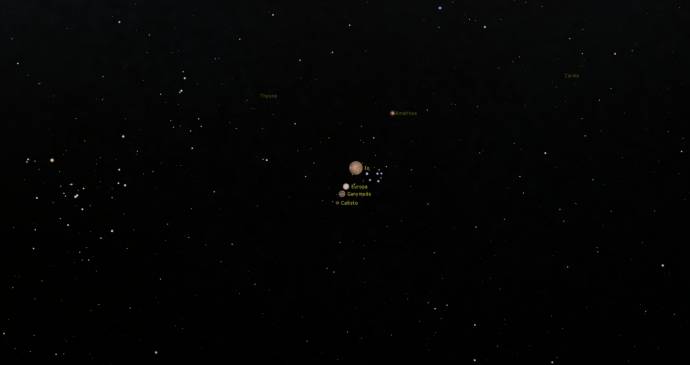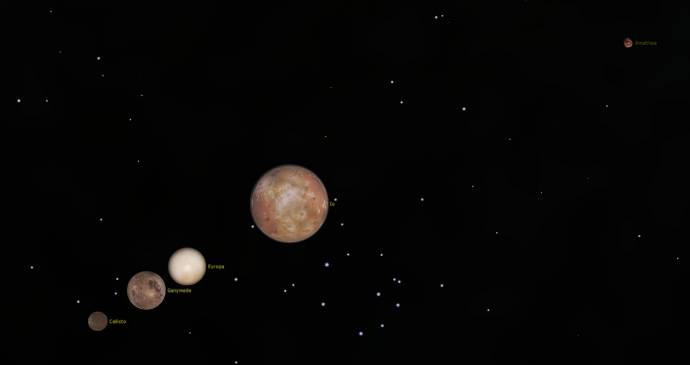| SpaceEngineer | Date: Thursday, 25.10.2012, 00:22 | Message # 1 |
 Author of Space Engine
Group: Administrators
 Russian Federation
Russian Federation
Messages: 4800
Status: Offline
| While reading this article, I wondered how to compare appearance of all moons of our Solar system's planets, as they are visible from their parent planet's surface. So I've opened this thread and will post here some observations made by SE. You are welcome to join in this work!
My favourite "place" in the Solar system is the Galilean moons. So I started with them. It is possible to catch a close approach of Io and Europa, Io and Ganymede, Europa and Ganymede, but not these three moons simultaneously, due to their resonant orbits. So I made a hack, using the editor - i just change their Epoch (well, I discovered and fixed a bug in the slider edit field, but the same result can be obtained by editing the orbital period). So, here is the "collage" of Jupiter's five biggest moons, as they are seen from it's equator:

The moons meet each other in Pleiades. The FOV of this screenshot is about 15°, so viewing it full-screen gives you the "real" size appearance, as you would observe them by naked eye. And here is the zoomed version:

The apparent size of the closest moons (Amalthea, Io and Europa) is changed significantly depending on it's height above the horizon - because Jupiter is a huge planet, moon's parallax is big enough. The maximum angular size each moon reaches at zenith. Io is just a bit bigger than our Moon visible from Earth, almost 36 arc minutes. Europa and Ganymede appears almost identical in size, 18 arc minutes (Ganymede is a bit bigger), and Callisto is only 9 arc minutes. So, Galilean moons apparent size is decreasing as 4:2:2:1 - the perfect sequence! Amalthea is big enough to be resolved by naked eye, about 5 arc minutes. Despite its irregular shape, its visible shape is almost perfectly round, because it's oriented by it's longer axis toward Jupiter.
Edit: I'd forgot to mention about the moon's brightness. Apparent magnitude of the full Io is almost as our Moon - about -11.2m (despite the higher distance to Sun, Io has a bigger albedo). Europa and Ganymede are -9.7m and -9.4m, and Callisto is -7.0m. Of course, you can't see the moons in full phase, because at this phase they will be inside Jupiter's shadow.
Quick info about other biggest moons: Titan is visible from Saturn's equator as an orange disk 16 arc minutes in size - a bit smaller than Europa and Ganymede. Triton's apparent size from Neptune's surface is 28 arc minutes - like our Moon! All other moons of the planets are much smaller. So Io is the biggest moon in planetary sky, our Moon is next, and Triton is third place (it is about their maximum size, it may change significantly due to geocentric parallax and orbital position). But of course, if we will consider dwarf planets, the biggest moon will be Charon - it's maximum angular size from Pluto's surface is about 3,4°.
*

|
| |
| |
| HarbingerDawn | Date: Thursday, 25.10.2012, 00:28 | Message # 2 |
 Cosmic Curator
Group: Administrators
 United States
United States
Messages: 8717
Status: Offline
| Quote (SpaceEngineer) While reading this article
Which article?
All forum users, please read this!
My SE mods and addons
Phenom II X6 1090T 3.2 GHz, 16 GB DDR3 RAM, GTX 970 3584 MB VRAM
|
| |
| |
| SpaceEngineer | Date: Thursday, 25.10.2012, 00:30 | Message # 3 |
 Author of Space Engine
Group: Administrators
 Russian Federation
Russian Federation
Messages: 4800
Status: Offline
| Quote (HarbingerDawn) Which article?
Oops, updated 

|
| |
| |